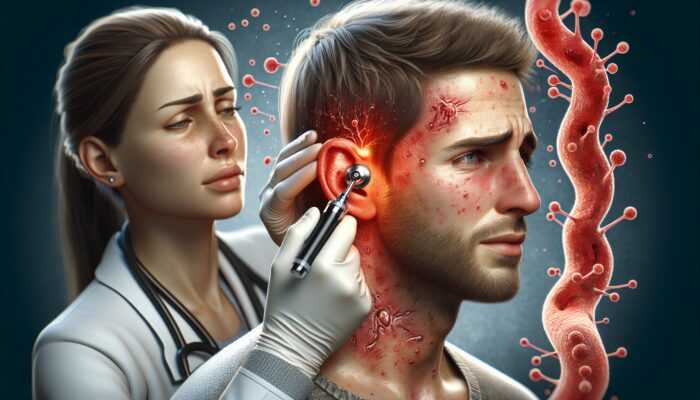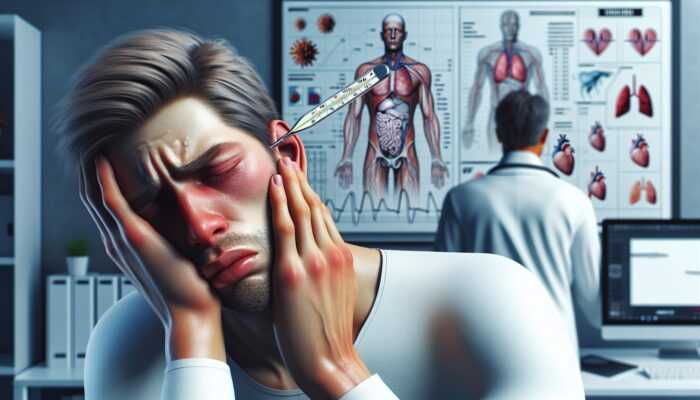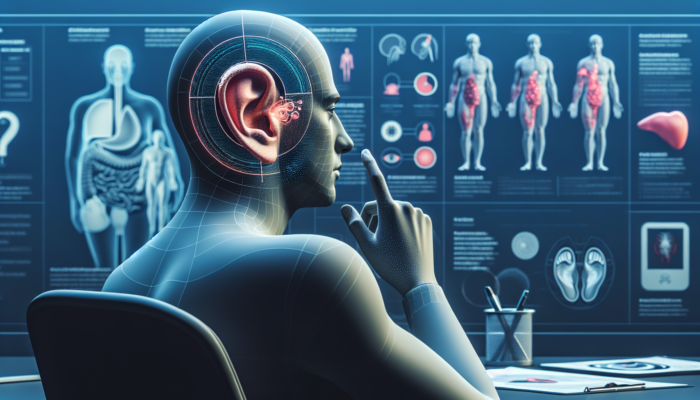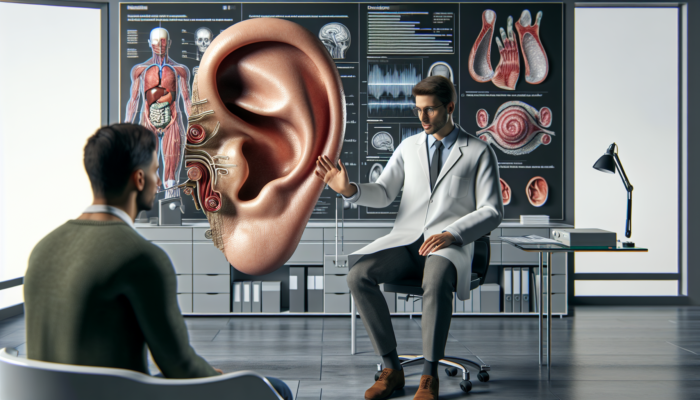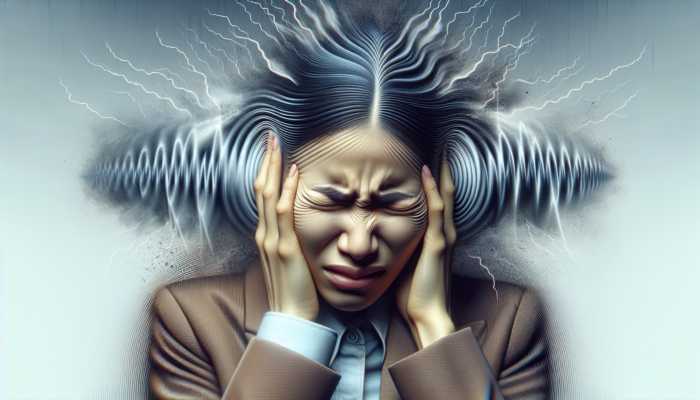Viral Infections’ Impact on Your Ears: A Universal Overview
Last Updated on 30/09/2025 by Admin
Exploring the Connection Between Viral Infections and Ear Health
What Viral Infections Are Commonly Linked to Ear Problems?

Viral infections play a crucial role in affecting ear health, leading to conditions such as otitis media, characterized by inflammation and fluid accumulation in the middle ear. The most common viral offenders include the flu, the common cold, and the respiratory syncytial virus (RSV). These viruses often infiltrate the ear via the Eustachian tube, which connects the middle ear to the throat, enabling viral migration from the respiratory tract into the ear. The inflammation caused by these viruses results in painful symptoms, disrupting normal ear function, and highlighting the importance of recognizing these prevalent infections.
Infections such as the flu not only compromise the respiratory system but can also induce significant ear discomfort. Symptoms like ear pain and a sense of pressure become common as inflammation and fluid buildup exert force on the eardrum. Similarly, the common cold, despite primarily affecting the nasal passages, can lead to secondary ear issues resulting in congestion and potential ear infections. Additionally, RSV, particularly prevalent in young children, can cause severe respiratory symptoms and is associated with an increased risk of ear infections, illustrating the intricate relationship between viral infections and ear health across all age groups.
Understanding these viral infections and their potential repercussions on ear health underscores the necessity for awareness and proactive measures. Recognizing symptoms early can lead to timely medical intervention, preventing complications that may arise from untreated ear infections.
How Do Viruses Manage to Enter the Ear?
Viruses primarily gain entry into the ear through the Eustachian tube, a small passage connecting the middle ear to the back of the throat. This anatomical structure serves as a conduit for infections, allowing viruses from the upper respiratory tract to access the ear. When someone contracts a viral illness like a cold or flu, inflammation and swelling in the nasal passages can block the Eustachian tube. This blockage disrupts normal drainage in the ear and creates a favorable environment for viral invasion.
Understanding the pathophysiology behind this process is vital for grasping how ear infections develop. When the Eustachian tube becomes obstructed, pressure builds in the middle ear, leading to fluid retention. This stagnant fluid provides an ideal breeding ground for viruses, resulting in inflammation of the ear structures. Moreover, viruses can directly invade the cells lining the Eustachian tube, worsening the infection and contributing to symptoms like ear pain and pressure.
Preventing viral entry into the ear is essential, particularly during peak seasons for respiratory illnesses. Individuals can adopt strategies like practicing good hand hygiene, avoiding close contact with infected individuals, and being vigilant about respiratory symptoms to minimize the likelihood of developing ear infections from viral origins.
What Symptoms Indicate a Viral Ear Infection?
Identifying the symptoms associated with viral ear infections is crucial for effective management and treatment. Common indicators include ear pain, hearing loss, fever, and a feeling of fullness in the ear. These symptoms often appear suddenly and can vary in intensity based on the severity of the infection. For example, ear pain can fluctuate from mild discomfort to severe, throbbing pain that disrupts daily activities and sleep.
Hearing loss is another critical symptom that can arise due to fluid accumulation in the middle ear, which dampens sound transmission. The sensation of fullness resembles pressure in the ear, akin to the feeling experienced when flying during takeoff or landing. This pressure imbalance within the ear leads to discomfort and potential hearing impairment.
Recognizing these symptoms early can facilitate timely treatment, preventing the escalation of the infection and diminishing the risk of complications. Parents and caregivers should be particularly attentive to these signs in children, who may not express their discomfort verbally. Observational cues such as tugging at the ear, irritability, or alterations in sleep patterns can signify an ear infection’s presence, prompting immediate medical evaluation.
The Effects of Viral Infections on Ear Functionality

How Do Viral Infections Impact Hearing and Balance?
Viral infections can significantly affect hearing and balance due to inflammation and fluid buildup in the ear. The middle ear, which is essential for sound transmission, can become obstructed as a result of these infections, impairing the ability of sound waves to reach the inner ear and resulting in temporary hearing loss. Furthermore, inflammation can disrupt the vestibular system, which is critical for maintaining balance, leading individuals to experience dizziness or a spinning sensation, thereby exacerbating their discomfort.
Typically, these symptoms resolve once the viral infection subsides, but the temporary impairment can disrupt daily life. For instance, individuals may struggle to engage in conversations or partake in activities requiring balance, such as sports or driving. Such disruptions can lead to feelings of frustration and a decrease in overall quality of life, especially if infections occur frequently.
In some situations, balance issues can be severe enough to imitate conditions like vertigo or labyrinthitis, complicating the individual’s experience further. Recognizing that these symptoms are linked to a viral infection rather than a chronic condition is crucial for appropriate management. Once the infection resolves, individuals often return to their normal levels of hearing and balance, underscoring the temporary nature of these symptoms.
How Long Do Symptoms Typically Last?
The duration of symptoms associated with viral ear infections can vary significantly, generally lasting from a few days to a couple of weeks. In most instances, individuals can expect gradual improvement within a week; however, some may experience lingering symptoms that persist longer. Factors influencing symptom duration include the specific virus involved, the individual’s immune response, and any underlying health conditions that might complicate recovery.
Acute symptoms often manifest quickly after viral exposure, peaking within two to three days. As the body mounts an immune response to combat the virus, symptoms may begin to diminish. However, if symptoms do not improve after five to seven days, it is imperative to seek medical attention, as persistent symptoms may indicate a secondary bacterial infection or complications that require intervention.
Additionally, the individual’s age and overall health significantly influence symptom duration. For example, children may experience more severe and prolonged symptoms due to their developing immune systems, whereas adults, particularly those with stronger immune responses, may recover more swiftly. Understanding these timelines is crucial for individuals dealing with viral ear infections, empowering them to monitor their health and access appropriate care when necessary.
Can Viral Infections Cause Permanent Damage to the Ear?

In rare instances, viral infections can lead to permanent ear damage, resulting in chronic conditions such as hearing loss or balance disorders. While most individuals fully recover from viral ear infections, certain factors may predispose some to more severe outcomes. For instance, recurrent infections can lead to scarring of the eardrum or damage to the delicate structures of the inner ear, which are vital for hearing and balance.
Prompt treatment of viral infections is crucial for minimizing these risks. Early intervention alleviates symptoms and decreases the likelihood of complications that could result in lasting damage. Individuals experiencing frequent viral ear infections should be closely monitored by healthcare professionals to prevent the progression to chronic ear conditions.
Moreover, the patient’s age significantly influences the potential for permanent damage. Young children, whose ear structures are still developing, may be particularly vulnerable to complications from untreated ear infections. Conversely, older adults may face increased risks due to age-related changes in ear anatomy and a generally weakened immune system.
Understanding the potential for long-term effects emphasizes the importance of early detection and management of viral ear infections. This proactive approach can protect ear health and maintain overall well-being.
Insights from Experts on Viral Infections and Ear Health
What Recent Research Reveals About Viral Ear Infections?
Recent studies have uncovered important insights into how viral infections influence ear health. Grasping these findings is vital for developing effective treatments and preventive strategies against viral ear infections. Some key highlights from recent research include:
- Identification of specific viruses that increase susceptibility to ear infections, particularly in children.
- Discovery of the role inflammation plays in impeding Eustachian tube function, leading to fluid buildup.
- Insights into how viral infections can disrupt the microbial balance in the ear, potentially paving the way for secondary bacterial infections.
- Examinations of the immune response and its implications for future vaccination strategies against common viral pathogens.
These findings illustrate the intricate relationship between viral infections and ear health, shaping both clinical practices and public health initiatives. For example, understanding the specific viruses that predispose young children to ear infections can lead to targeted vaccination efforts and improved parental education on prevention methods.
Additionally, recognizing inflammation’s role in Eustachian tube dysfunction allows for the development of novel therapies aimed at reducing inflammation and its effects on ear health. These advancements are critical for enhancing patient outcomes and lowering the overall incidence of viral ear infections.
As research progresses, experts remain hopeful that these insights will inspire innovative treatment methods and preventive strategies that can significantly bolster ear health across various populations.
How Do Medical Professionals Diagnose Viral Ear Infections?
Diagnosing viral ear infections typically requires a comprehensive approach that includes a physical examination, a review of the patient’s medical history, and, in some cases, additional diagnostic tests. The physical examination often involves an otoscopic evaluation, where the healthcare provider inspects the ear canal and eardrum for signs of infection, fluid accumulation, or inflammation.
Medical history is equally important, as understanding recent illnesses, symptoms, and any recurrent ear infections can provide valuable context for diagnosis. In certain cases, additional tests such as imaging studies or hearing assessments may be conducted, particularly if a more complex condition is suspected or if the patient presents with atypical symptoms.
Effective diagnosis involves several actionable steps:
- Conducting a thorough otoscopic examination to identify signs of infection.
- Collecting detailed medical history to uncover patterns or recurrent issues.
- Performing hearing tests to evaluate the infection’s impact on auditory function.
- Considering imaging studies if complications or persistent symptoms are suspected.
Accurate diagnosis is vital for effective treatment. Misdiagnosis can lead to inappropriate management, prolonging symptoms and increasing the risk of complications. Therefore, a systematic approach to diagnosis enables healthcare providers to tailor treatment plans that meet each patient’s specific needs.
What Preventive Measures Do Experts Recommend for Viral Ear Infections?
Experts advocate for a comprehensive approach to preventing viral ear infections, emphasizing hygiene, vaccination, and lifestyle modifications. By adopting these strategies, individuals can effectively reduce their risk of developing viral infections that may impact ear health. Key prevention strategies include:
- Practicing good hygiene, such as regular hand washing and avoiding face touching.
- Limiting close contact with sick individuals to decrease viral transmission.
- Staying current with vaccinations, especially against viruses like the flu and RSV.
- Encouraging breastfeeding in infants, as it enhances immune protection during early development.
Good hygiene practices, including frequent hand washing, are pivotal in preventing the spread of viruses that lead to ear infections. Implementing simple measures, like using hand sanitizer and maintaining a clean living space, can significantly impact overall health.
Vaccination is another essential aspect of prevention. Vaccines help individuals develop immunity against viral pathogens responsible for ear infections, thereby reducing incidence rates and the potential for complications. Breastfeeding is highly recommended for infants, providing vital antibodies and nutrients that strengthen the immune system.
Embracing these preventive strategies not only benefits individual health but also fosters community-wide immunity, diminishing the prevalence of viral infections and their associated ear health complications.
Available Treatments for Viral Ear Infections
What Are the Standard Treatments for Viral Ear Infections?
Treatment for viral ear infections primarily centers on symptom relief, as antibiotics are ineffective against viral pathogens. Common treatments include pain relief medications, decongestants, and supportive measures to aid recovery. Nonsteroidal anti-inflammatory drugs (NSAIDs), such as ibuprofen or acetaminophen, are frequently suggested to alleviate pain and lower fever. These medications can notably enhance comfort while the body combats the viral infection.
In cases where nasal congestion is pronounced, decongestants may be prescribed to assist in clearing the Eustachian tubes and normalizing ear pressure. This can alleviate symptoms like fullness and discomfort. Additionally, maintaining adequate hydration and resting is vital for promoting recovery, allowing the body to focus on healing.
While viral infections generally resolve on their own, healthcare providers may monitor for potential secondary bacterial infections. If such infections develop, antibiotics may be required. Therefore, individuals experiencing persistent or worsening symptoms should seek medical attention to ensure proper management.
The focus on supportive care and monitoring highlights the importance of patient education regarding the nature of viral infections. Understanding that most viral ear infections will resolve over time empowers individuals to manage their symptoms effectively while prioritizing recovery.
Are Home Remedies Effective for Viral Ear Infections?
Home remedies can offer additional relief for individuals dealing with viral ear infections, but their effectiveness can vary significantly. Common home remedies include warm compresses, steam inhalation, and saltwater gargles. Applying warm compresses to the affected ear can help alleviate pain and discomfort, as the heat promotes blood flow and may reduce inflammation.
Steam inhalation can also be advantageous for relieving nasal congestion, facilitating better drainage of the Eustachian tubes. This method involves inhaling steam from a bowl of hot water or taking a warm shower, which can help clear mucus from the respiratory tract and ears. Saltwater gargles may temporarily relieve throat discomfort linked to viral infections, although they do not directly address ear symptoms.
While these home remedies can assist in symptom management, they should not replace medical treatment, particularly if symptoms persist or worsen. It is crucial for individuals to remain alert and seek professional care if home remedies do not yield substantial improvement. Additionally, discussing the use of home remedies with a healthcare provider ensures they are suitable for the individual’s specific circumstances.
Overall, home remedies can be a helpful complement to conventional treatments, providing comfort and relief during the recovery process when used judiciously.
When Should You Seek Medical Attention for Viral Ear Infections?
Recognizing the appropriate time to seek medical attention for viral ear infections is essential for preventing complications. Individuals should consult a healthcare provider if symptoms persist beyond a week, worsen, or if they experience severe pain or a high fever. These signs could indicate a secondary bacterial infection or other complications necessitating medical intervention.
In particular, symptoms like pus drainage from the ear, severe and escalating pain despite over-the-counter treatments, or marked hearing loss warrant immediate medical evaluation. Additionally, if an individual develops signs of systemic infection, such as chills, sweats, or significant fatigue, these may also serve as red flags that require prompt attention.
For parents, being attentive to changes in their child’s behavior can provide crucial clues. If a child is unusually irritable, has difficulty sleeping, or displays distress when lying down, these may signal the need for medical evaluation. Early intervention can lead to more effective treatment pathways, reducing the risk of complications that could arise from untreated ear infections.
Ultimately, proactive symptom monitoring and seeking medical advice when necessary are critical components of managing viral ear infections. This approach not only alleviates discomfort but also protects long-term ear health.
How Viral Infections Affect Different Age Groups
What Is the Impact of Viral Infections on Children?
Children are particularly vulnerable to viral ear infections due to their anatomical and physiological characteristics. Their Eustachian tubes are shorter and more horizontally oriented, making it easier for viruses and bacteria to migrate from the throat to the middle ear. This anatomical predisposition leads to higher incidences of otitis media, especially during seasons of respiratory infections.
Symptoms in children can be more severe and frequent, resulting in significant discomfort and potential complications if not addressed promptly. Parents should be vigilant for signs such as tugging at the ear, irritability, and disrupted sleep patterns, as children may not verbalize their pain. Early intervention and treatment are vital to prevent the emergence of chronic ear issues that could impact hearing and speech development.
Moreover, recurrent ear infections during childhood can lead to long-term consequences, including potential hearing loss or persistent fluid in the ears, which can hinder language acquisition and academic performance. Thus, understanding the unique impact of viral infections on children highlights the significance of preventive measures and timely medical care.
What Are the Effects of Viral Infections on Adults?
Adults may experience viral ear infections less frequently than children, but when they do occur, the symptoms can still be substantial. Factors such as stress, allergies, and pre-existing health conditions can contribute to the likelihood of developing viral ear infections in adults. Symptoms may manifest as intense ear pain, hearing loss, and a sensation of fullness, which can disrupt daily activities and work.
Chronic conditions can arise if adults experience recurrent infections, leading to complications like persistent middle ear fluid or damage to the eardrum. Adults are also more likely to disregard symptoms, assuming they will resolve independently, which can delay treatment and exacerbate issues. Acknowledging the importance of addressing ear infections promptly can empower adults to seek timely medical care, thus preventing long-term complications.
The psychological impact of viral ear infections in adults should not be overlooked. Hearing loss or balance issues resulting from ear infections can significantly affect quality of life, influencing social interactions and professional performance. Therefore, recognizing and managing viral ear infections is essential for maintaining overall health and well-being in adults.
What Considerations Are There for the Elderly?
The elderly population faces unique challenges regarding viral ear infections, primarily due to age-related changes in the immune system and ear anatomy. With a generally weakened immune response, older adults are more prone to complications from viral infections, which can lead to severe outcomes, including chronic ear diseases or significant hearing loss.
Additionally, the presence of other comorbidities, such as diabetes or cardiovascular issues, can complicate the management of viral ear infections in older adults. Symptoms such as dizziness or balance issues can pose significant safety risks, increasing the chances of falls or other injuries. Therefore, special care and monitoring are necessary for this demographic.
Healthcare providers should emphasize preventive measures, such as vaccinations against common viruses and regular check-ups to monitor ear health. Educating elderly patients and their caregivers about the signs of viral ear infections can facilitate early detection and prompt treatment, safeguarding their quality of life.
What Is the Impact on Adolescents?
Adolescents may experience viral ear infections less frequently than younger children but more often than adults. Their developing immune systems can influence the severity and duration of symptoms. Changes in lifestyle and behavior during adolescence, such as increased exposure to crowded environments, can also contribute to a heightened risk of viral infections.
Symptoms in adolescents may include ear pain, fullness, and temporary hearing loss, which can impair their ability to concentrate in school or participate in extracurricular activities. Awareness of these symptoms is crucial, as adolescents may be less communicative about their discomfort. Parents and caregivers should encourage open communication, prompting adolescents to report any unusual symptoms promptly.
The psychological impact of ear infections during adolescence should not be underestimated. Concerns about appearance and social interactions can intensify feelings of frustration and isolation when experiencing hearing loss or balance issues. By recognizing the unique challenges faced by adolescents, healthcare providers can tailor preventive strategies and treatment options that meet their specific needs.
Complications and Long-Term Effects of Viral Ear Infections
What Complications Can Arise from Viral Ear Infections?
Viral ear infections can lead to several complications, underscoring the importance of timely diagnosis and treatment. Potential complications include chronic ear infections, hearing loss, and balance disorders. Chronic ear infections can develop when viral infections remain unresolved, resulting in ongoing inflammation and fluid accumulation in the middle ear. This situation may lead to a cycle of recurrent infections that necessitate medical intervention and, in some cases, surgical procedures.
Hearing loss is another significant risk associated with untreated viral ear infections. If the infection causes prolonged fluid build-up, it can impede sound transmission and lead to temporary or, in rare cases, permanent hearing impairment. This concern is especially critical for children, as hearing loss can adversely affect language development and academic success.
Balance disorders represent another potential complication, as the vestibular system is closely linked to the ear. Viral infections can disrupt the normal functioning of this system, causing dizziness or a sensation of spinning. Early recognition of these complications can make a crucial difference in treatment outcomes, emphasizing the importance of vigilant monitoring during viral infections.
What Is the Long-Term Impact on Ear Health?
Recurrent viral ear infections can have lasting effects on ear health, leading to structural changes that impact hearing and balance. Chronic inflammation and fluid retention can result in long-term consequences, including scarring of the eardrum or dysfunction of the Eustachian tube. These alterations can hinder normal ear function, causing ongoing issues that may necessitate medical or surgical intervention.
Furthermore, individuals with a history of recurrent ear infections may develop a condition known as otitis media with effusion, where fluid persists in the middle ear even after the infection has resolved. This condition can contribute to hearing loss and may require tympanostomy tubes to facilitate drainage and prevent future infections.
Regular check-ups are essential for individuals with a history of viral ear infections, allowing healthcare providers to monitor ear health and address any emerging concerns promptly. This proactive approach can mitigate the long-term effects of recurrent infections and enhance overall quality of life.
Can Viral Ear Infections Lead to Other Health Issues?
Viral ear infections can sometimes lead to secondary bacterial infections or escalate into more serious health issues, such as sinusitis or meningitis. The proximity of the ear to the brain and the interconnected nature of the upper respiratory system means that infections can spread, resulting in potentially severe complications.
For instance, if a viral ear infection is left untreated, it may create an environment conducive to bacterial growth, leading to a secondary bacterial ear infection. This scenario is not uncommon and may require antibiotics for effective treatment. Additionally, the spread of infection from the ear to surrounding structures can result in complications like mastoiditis, where the mastoid bone becomes infected, necessitating urgent medical care.
Understanding the potential for complications underscores the importance of prompt diagnosis and treatment of viral ear infections. Regular medical follow-ups and vigilance for unusual symptoms can help prevent the escalation of infections and safeguard overall health.
Research-Backed Insights on How Viral Infections Influence Ear Health
What Does Research Indicate About the Immune Response to Viral Ear Infections?
Recent studies indicate that the immune response to viral ear infections plays a crucial role in building resistance to future infections. Understanding the mechanisms behind this immune response can aid in developing more effective treatments and preventive measures.
Research has revealed that when the body encounters a viral infection, it activates various immune pathways, generating antibodies and inflammatory responses aimed at eliminating the virus. This immune memory can provide protection against future infections from the same virus. For instance, studies have demonstrated that individuals with prior viral ear infections often report fewer occurrences over time, suggesting their immune systems have adapted.
Real-world examples of immune responses can be seen in the context of vaccinations. Vaccines instruct the immune system to recognize and respond more efficiently to certain viral pathogens, reducing the incidence of infections that lead to ear complications. Understanding how the immune system reacts to viral infections is essential for developing targeted immunizations and therapies that enhance ear health.
How Do Viral Infections Contribute to Medical Advancements?
Studying viral ear infections has led to significant advancements in understanding viral pathology and developing new treatments. Ongoing research into how viruses affect ear health helps inform clinical practices and public health policies.
One notable advancement includes the creation of antiviral medications specifically targeting viral infections known to cause ear complications. Research has also enabled improved diagnostic techniques that can differentiate between viral and bacterial infections, ensuring patients receive appropriate treatment without unnecessary antibiotic use.
Furthermore, understanding the dynamics of viral infections has implications for broader medical knowledge, influencing the development of therapeutic strategies across various fields. Future research should explore genetic factors influencing susceptibility to viral infections and investigate the long-term impacts of viral infections on ear health across diverse populations.
Continued funding and support for research initiatives focused on viral ear infections are essential for improving patient outcomes and advancing our understanding of these complex interactions.
What Are the Long-Term Benefits of Studying Viral Ear Infections?
Long-term studies on viral ear infections can lead to better prevention strategies and treatments, ultimately enhancing overall ear health. By examining patterns and outcomes associated with viral infections over extended periods, researchers can gain insights into the long-term effects on hearing and balance, informing clinical practices and public health initiatives.
Such studies may reveal critical information regarding the efficacy of preventive measures, such as vaccinations or public health campaigns, allowing for the refinement of strategies aimed at reducing the incidence of viral ear infections. Additionally, understanding the socio-economic consequences of viral ear infections in various populations can help inform resource allocation and healthcare policies.
Experts emphasize that long-term research is vital for identifying trends and establishing best practices for managing viral ear infections. Implementing findings from these studies can lead to improved quality of life for individuals affected by ear health complications, ultimately benefiting society as a whole.
Effective Prevention Strategies for Viral Ear Infections
What Hygiene Practices Are Effective in Preventing Viral Infections?
Implementing effective hygiene practices is crucial in reducing the spread of viruses that can lead to ear infections. Regular hand washing, avoiding face touching, and maintaining a clean environment are simple yet effective strategies that can significantly lower the risk of viral infections.
Frequent hand washing, particularly after being in public places or after contact with sick individuals, is one of the most effective ways to prevent viral transmission. This practice eliminates potential pathogens before they can enter the body. Additionally, avoiding touching the face—especially the nose and mouth—can further reduce the likelihood of contracting viruses that may migrate to the ears.
Maintaining a clean living environment is equally important. Regularly disinfecting commonly-touched surfaces, such as doorknobs, light switches, and mobile devices, can help minimize the spread of viruses. Fostering a culture of cleanliness at home and in public spaces promotes healthier communities, ultimately protecting individuals from viral ear infections.
Adopting these hygiene practices fosters a proactive approach to health, empowering individuals to take charge of their well-being and reduce the incidence of viral ear infections.
Why Are Vaccinations Important in Preventing Ear Infections?
Vaccinations play an essential role in preventing viral infections that may lead to ear issues. Vaccines against common viruses, such as the flu and measles, are crucial for safeguarding individuals from infections that can cause complications like ear infections. Staying up-to-date with vaccinations helps build immunity and reduce the spread of these viruses within the community.
The flu vaccine, for example, is particularly important during colder months when respiratory infections peak. By obtaining the flu vaccine, individuals significantly lower their risk of contracting influenza and its associated complications, including ear infections. Vaccination not only protects the individual but also contributes to herd immunity, reducing the overall prevalence of viral infections in the population.
Public health initiatives that clearly communicate the importance of vaccinations, especially for children and vulnerable populations, can lead to higher vaccination rates and better community health outcomes. Promoting vaccinations as a key component of preventive care empowers individuals to take proactive measures against viral infections threatening ear health.
What Lifestyle Changes Can Help Reduce the Risk of Viral Infections?
Making lifestyle changes can significantly reduce the risk of viral ear infections and improve overall health. A balanced diet rich in fruits, vegetables, and whole grains supports a robust immune system, enhancing the body’s resilience to infections. Regular exercise has also been shown to boost immune function, promoting better health and reducing the likelihood of viral illnesses.
Moreover, ensuring adequate sleep is crucial for maintaining a well-functioning immune system. Sleep deprivation can impair immune responses, leaving individuals more vulnerable to viral infections. Prioritizing sleep hygiene and establishing a consistent sleep schedule can be beneficial for overall health.
Stress management is another important consideration, as chronic stress can weaken the immune system, making individuals more susceptible to infections. Incorporating stress-reducing practices, such as mindfulness, yoga, or engaging in hobbies, can positively impact both mental and physical health.
By adopting these lifestyle changes, individuals can create a healthier environment that reduces their risk of viral ear infections, ultimately promoting better ear health and overall well-being.
Managing Viral Ear Infections in Daily Life
How Can You Cope with Symptoms at Home?
Managing symptoms of viral ear infections at home involves a combination of rest, hydration, and the use of over-the-counter pain relievers. Ensuring adequate rest allows the body to focus on recovery, while staying hydrated helps thin mucus and promote drainage from the ears. Drinking plenty of fluids, such as water, herbal teas, and broths, can provide additional comfort during recovery.
Over-the-counter pain relievers, such as ibuprofen or acetaminophen, can effectively alleviate ear pain and reduce fever. Adhering to dosing instructions is crucial to ensure safety and effectiveness. Furthermore, applying warm compresses to the affected ear can provide soothing relief from pain and discomfort.
While home management can be effective for mild symptoms, individuals should remain vigilant for any signs of worsening or persistent symptoms. If symptoms do not improve within a week or if severe pain develops, seeking medical attention becomes essential to prevent complications.
By employing these strategies, individuals can manage the symptoms of viral ear infections and facilitate a smoother recovery process at home.
What Adjustments Can Be Made at Work or School?
Making adjustments at work or school can help individuals manage symptoms of viral ear infections and prevent their condition from worsening. Taking time off when experiencing significant symptoms is vital for recovery, allowing the body to concentrate on healing without the added stress of daily responsibilities. Informing supervisors or teachers about the situation can foster understanding and support during the recovery period.
Utilizing ear protection, such as earplugs or noise-canceling headphones, can help minimize exposure to loud noises that may exacerbate discomfort or balance issues. This is especially important for individuals who work in noisy environments or attend classes in large lecture halls.
Additionally, avoiding strenuous activities and prioritizing self-care during this time is crucial. Engaging in lighter tasks or taking breaks to rest can help manage symptoms and ensure comfort. If possible, creating a quiet and comfortable workspace or learning environment can further facilitate recovery.
Taking these proactive measures can significantly aid in symptom management and enhance the recovery experience for individuals dealing with viral ear infections.
How Can You Maintain Ear Health After an Infection?
After recovering from a viral ear infection, maintaining ear health is essential for preventing future infections. Regular check-ups with healthcare providers can help monitor ear health and address any lingering symptoms that may indicate complications. Routine examinations ensure that any issues are identified early, allowing for timely intervention and management.
Continuing good hygiene practices post-infection is equally important. Regular hand washing, avoiding close contact with sick individuals, and maintaining a clean living environment can help reduce the risk of subsequent viral infections. Additionally, individuals should remain vigilant for any signs of recurring symptoms, such as ear pain or fullness.
Educating oneself about the signs and symptoms of ear infections can facilitate early detection and treatment. Being proactive about ear health empowers individuals to take charge of their well-being and prevent future issues.
Adopting these strategies post-infection can significantly enhance ear health and contribute to overall wellness.
When Should You Seek Medical Attention After an Infection?
Knowing when to seek medical attention after a viral ear infection is crucial for preventing complications. Individuals should consult a healthcare provider if symptoms worsen or persist beyond a few days. Signs such as severe pain, high fever, or pus drainage from the ear warrant immediate evaluation, as they could indicate a secondary bacterial infection or other complications.
Additionally, if individuals experience significant hearing loss or balance issues that do not improve, seeking medical advice becomes essential. These symptoms could signal underlying problems requiring further investigation and treatment.
For parents, being aware of changes in a child’s behavior, such as increased irritability or difficulty sleeping, can indicate the need for medical consultation. Early intervention can make a significant difference in outcomes, ensuring that individuals receive the necessary care to promote recovery and prevent complications.
Being proactive about seeking medical attention when needed is an integral part of managing viral ear infections and safeguarding ear health.
Frequently Asked Questions
What Are the Most Common Viruses Responsible for Ear Infections?
Common viruses include the flu virus, rhinovirus (common cold), and respiratory syncytial virus (RSV), all of which can lead to viral ear infections.
Can Adults Experience Viral Ear Infections?
Yes, adults can experience viral ear infections, although they are less common compared to children. Symptoms can still be significant and may require medical attention.
How Can I Prevent Viral Ear Infections?
Prevent viral ear infections by practicing good hygiene, getting vaccinated against common viruses, and making healthy lifestyle choices to bolster your immune system.
What Signs Indicate That a Viral Ear Infection Is Serious?
Signs of a serious viral ear infection include severe ear pain, persistent symptoms lasting more than a week, fever exceeding 101°F, or pus drainage from the ear.
Is It Safe to Use Home Remedies for Ear Infections?
Home remedies like warm compresses or steam inhalation can provide relief but should not replace medical treatment. Always consult a healthcare provider if symptoms persist.
What Is the Typical Duration of a Viral Ear Infection?
A viral ear infection typically lasts from a few days to a couple of weeks, depending on the individual’s immune response and the severity of the infection.
What Complications Can Result from Viral Ear Infections?
Complications may include chronic ear infections, hearing loss, balance disorders, or the spread of infection to nearby structures, such as the mastoid bone.
Can Infants Develop Viral Ear Infections?
Yes, infants are highly susceptible to viral ear infections due to their developing immune systems and shorter Eustachian tubes, making prompt recognition and treatment essential.
Are Specific Vaccines Available for Preventing Ear Infections?
While there is no vaccine specifically for ear infections, vaccines for viruses like influenza and pneumococcus can help prevent the illnesses that lead to ear infections.
What Should I Do If My Symptoms Worsen After Treatment?
If symptoms worsen, seek medical attention immediately. This may indicate a secondary bacterial infection or other complications requiring further evaluation and treatment.
Explore our journey on X!
The post Viral Infections’ Impact on Your Ears: A Universal Overview appeared first on The Microsuction Ear Wax Removal Network.


























